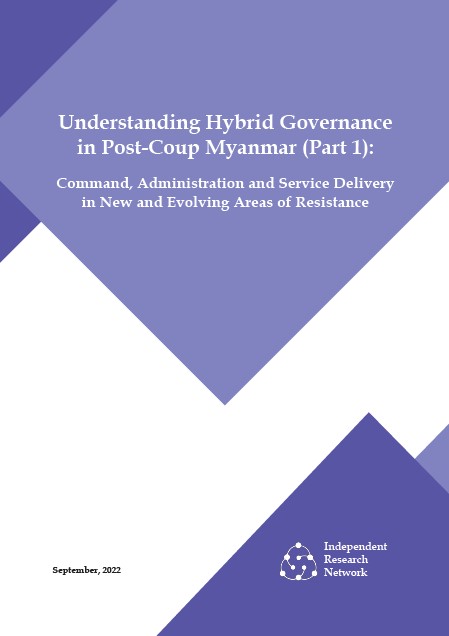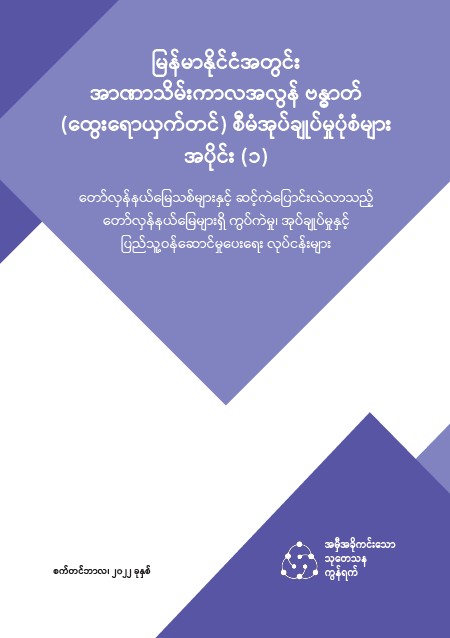Report
110 Views
Understanding Hybrid Governance in Post-Coup Myanmar (Part 1)
September 15th, 2022 •
Author:
Independent Research Network
•
6 minute read



Executive Summary
- The SACs attempt to remilitarise local administration after the February 2021 coup led to the collapse of Myanmar government administrative and service delivery functions, especially in rural areas of lowland and Dry Zone regions. This vacuum has prompted a variety of new governance actors – often linked to resistance forces – to assume roles in administration and service delivery.
- The functions fulfilled by non-state social actors vary considerably across contexts and often build on networks, organisations and practices that existed prior to the coup. These include justice and dispute resolution along with education and health service delivery.
- Across contexts armed resistance forces are playing varied roles in civilian administrative structures at village, township and regional levels. The blurring of functions varies depending on regional context, with some attempts to separate the spheres of armed resistance and governance across the townships and regions examined.
- In most areas of Sagaing Region and Chin State SAC departments are no longer functioning outside of the urban core of townships. This has fragmented how people, especially in rural areas, experience education and health systems at a sub-township level. In this vacuum, most governance decisions are taken at a local level and new public services including schools, clinics and legal services are being run by local People’s Administrative Bodies (PABs) in collaboration with parahita (welfare) groups and volunteers along with striking
- civil servants. Young people under 35 are disproportionately represented in resistance and governance bodies, though tribal elders also have a significant role in Chin State.
- In contrast, in most of Rakhine State public services such as loan services, maternal and elder cash support programmes and health services are largely uninterrupted as the Arakan Army and its political wing, the United League of Arakan (ULA) has, for now, accommodated existing SAC services by collaborating with local SAC bureaucrats for their political project.
- Justice provision varies across contexts. In Chin State most village-level conflict settlement in southern Chin State is carried out through mediation by ambassadors or negotiators. In Rakhine, since the coup the ULA has established its own court system that run parallel to SAC courts and processes, and emphasise local norms rather than Myanmar court procedures. NUG attempts to establish justice mechanisms at a township level in Sagaing region is interrupted by the instability created by ongoing conflict and the resultant limitations on administrative coordination between local PDFs and PABs.
- The National Unity Government (NUG) varies in its influence. In some contexts, local administrators are following NUG guidelines for the conduct of wartime policing, justice and service delivery. However, staff in non-SAC governance including schools and clinics are largely self-financing and report receiving minimal material aid from the NUG.
- In northern areas of Sagaing Region there is a strong degree of command coordination between local PDFs and the KIA, enabling a degree of NUG accountability. In the southern townships of Sagaing Region the coordination between local PDFs is more diffuse and informal and resistance forces in these areas are more independent of each other and NUG oversight. There is no discernable regional-level body coordinating armed resistance and administrative systems in Sagaing Region, in contrast to Chin and Rakhine States. In a context of regular aerial bombardment and ground assault by SAC forces, the expansive military and informational role of local PDF members in Sagaing Region has blurred the lines between civilian administration and armed resistance. This has led resistance forces to be enlisted into a range of PAB committees at a village level.
- In Chin State, governance and coordination of anti-SAC resistance in Chin State, including communication with the NUG and its Ministry of Defence, occurs via a state-level committee which includes representatives of armed resistance groups, civil society and politicians elected in November 2020. Local resistance forces play only an informal role in governance below the township level. Instead, tribal elders and civilian structures which were already integrated into conflict resolution at a sub-township level prior to the coup have become more important following the collapse of SAC administration below the township-level. Several interviewees involved in administration explained this as a conscious choice to distinguish between arms carriers and civilian decision-making.
- In Rakhine State governance is shaped by coordinated decision-making of regional commanders of Arakan Army (AA) and political representatives of the ULA, its political wing. Regional administration bodies comprised of AA and ULA representative serve as the supervisory authority for local governance. They provide guidelines and directives to all subordinate administration units while exercising judicial authority as well. The ULA partly accommodates and coopts the pre-existing GAD apparatus. ULA-endorsed GAD administrators continue to facilitate access to and delivery of SAC state initiatives including distribution of cash transfer programmes for new mothers and the elderly. They also support departmental functions including collection of fees and taxes.
- The evolving governance and social role played by non-state resistance forces post-coup highlight the need for substantive technical, financial, and in-kind support to civilian actors seeking to deliver essential public goods to conflict-impacted communities.
- International donors must seek ways to engage with these groups and practices in ways that support the delivery of much needed services, whilst also strengthening governance structures that define the appropriate wartime role of armed actors in civilian administration.
- The NUG and international partners should seek to identify realistic roles they can play in different contexts, especially how best they can support the delivery of services and respond to humanitarian needs in different contexts. Support could vary from setting guidelines around service delivery to provision of resources and support to local actors already engaged in filling social gaps, potentially through the brokerage of international donor aid.
- Engagement with wartime structures of social governance must be tailored to the context. In some areas it may be feasible for domestic and international partners to support training and resourcing of non-SAC social service and governance systems via an expansion of existing funding partnerships with ethnic civil society groups. Many of these groups already have direct relationships with non-SAC health, education and governance actors in specific regions or townships, which could be expanded and deepened with additional support.

